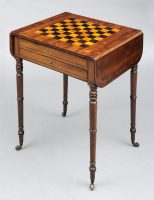Pembroke & Sofa View All Tables
The Pembroke Table
Antique Pembroke tables are said to be named for Henry Herbert (1693-1751), the 9th Earl of Pembroke, architect, peer and courtier to King George II. Interesting note: He was probably the first vegetarian and vegan since his diet consisted of beetroot and watercress. Now back to the Pembroke table. The table is very stylish and very versatile. It has two drop leaves or flaps which are hinged and are supported by butterfly brackets that extend out under the leaf, two drawers at either end, supported by four legs on casters.
The reason for casters on English furniture was mobility. In the 17th and 18th century, rooms were not arranged the way we decorate today. Furniture was placed against the wall in the large hall. When breakfast was being served, the servant would roll the breakfast table to the middle of the room for use along with the chairs. When meal time was over the table would be rolled back to stand against the wall until its next use. When it was time to play cards or games after dinner, the card table or Pembroke table would be moved to its desired position in the hall and set up and then moved back to the wall when game time was over. And so on with all other pieces of furniture.
Pembrokes were small, light, and usually made of mahogany, rosewood or satinwood and have exotic veneers and inlays and were very versatile. They can be used for eating, as an end table for photos or mementos, as a writing table or just enjoying a cup of tea on its flap.
The antique sofa table was an extended form of the Pembroke table. Today we put it behind the sofa and place lamps on it.
All three 18th century furniture designers, Chippendale, Sheraton and Hepplewhite, had patterns for Pembrokes and sofa tables in their design books.
 755 North Main Street, Route 7
755 North Main Street, Route 7